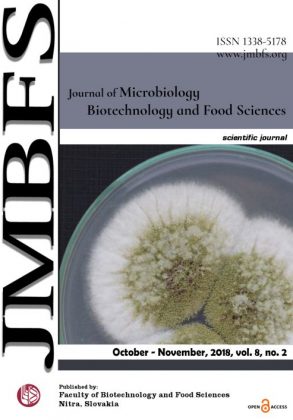POLLEN CAN - TESTING OF BEE POLLEN FERMENTATION IN MODEL CONDITIONS
DOI:
https://doi.org/10.15414/jmbfs.2018.8.2.805-811Keywords:
beekeeping, protein, better digestibility, lactic acid bacteria, microscopic fungiAbstract
The aim of the study was to simulate bee work with pollen by its fermentation in model conditions and evaluate the final product, which is called - pollen can. Bee pollen grain has thick wall, which is reason of its poor digestibility in organism. Bee pollen after fermentation is more suitable for human organism because of easily-available nutrients. Fresh bee pollen was added into the solution water-honey (with/without yoghurt) and was fermented. We tested 3 types of pollen and 3 types of honey in 3 ways of fermentations, which differed in starter addition, access of oxygen during fermentation and its time. The physico-chemical and microbiological parameters were measured in raw materials and products. Pollen can contained approximately 40% of water, 5% of fat and pH was approximately 4.5. These physico-chemical properties were influenced notably by pollen as raw material. The highest water content was found in rape pollen and consequently rape pollen cans. TPC (total plate count) of pollen can ranged from 4.10 to 7.10 log CFU.g-1 after fermentation and depend on type of pollen and fermentation process. We observed decrease of bacteria from Enterobacteriaceae family and microscopic filamentous fungi after fermentation in all 3 testing performances, whereas counts of sporulating aerobic microorganisms, yeasts and preliminary LAB (lactic acid bacteria) were stable, in comparison to pollen as raw material. Bacilli and clostridia from group of sporulating bacteria were recorded and identified. Value of pH less than 4.5 is important due to avoid clostridia germination.Downloads
Download data is not yet available.
Downloads
Published
2018-10-01
How to Cite
Kňazovická, V., ÄŒanigová, M., KroÄko, M., Ducková, V., Tokár, M., Repková6, M., Gamráthová, I., Gažarová, M., IvaniÅ¡ová, E., Salmonová, H., Å vejstil, R., Vlková, E., MaÅ¡ková, Z., & KaÄániová, M. (2018). POLLEN CAN - TESTING OF BEE POLLEN FERMENTATION IN MODEL CONDITIONS. Journal of Microbiology, Biotechnology and Food Sciences, 8(2), 805–811. https://doi.org/10.15414/jmbfs.2018.8.2.805-811
Issue
Section
Food Sciences
License
Copyright (c) 2018 VladimÃÂra Kňazovická, Zuzana MaÅ¡ková, Eva Vlková, Roman Å vejstil, Hana Salmonová, Eva IvaniÅ¡ová, Martina Gažarová, Iveta Gamráthová, Monika Repková6, Marián Tokár, Viera Ducková, Miroslav KroÄko, Margita ÄŒanigová, Miroslava KaÄániová

This work is licensed under a Creative Commons Attribution 4.0 International License.
All papers published in the Journal of Microbiology, Biotechnology and Food Sciences are published under a CC-BY licence (CC-BY 4.0). Published materials can be shared (copy and redistribute the material in any medium or format) and adapted (remix, transform, and build upon the material for any purpose, even commercially) with specifying the author(s).





